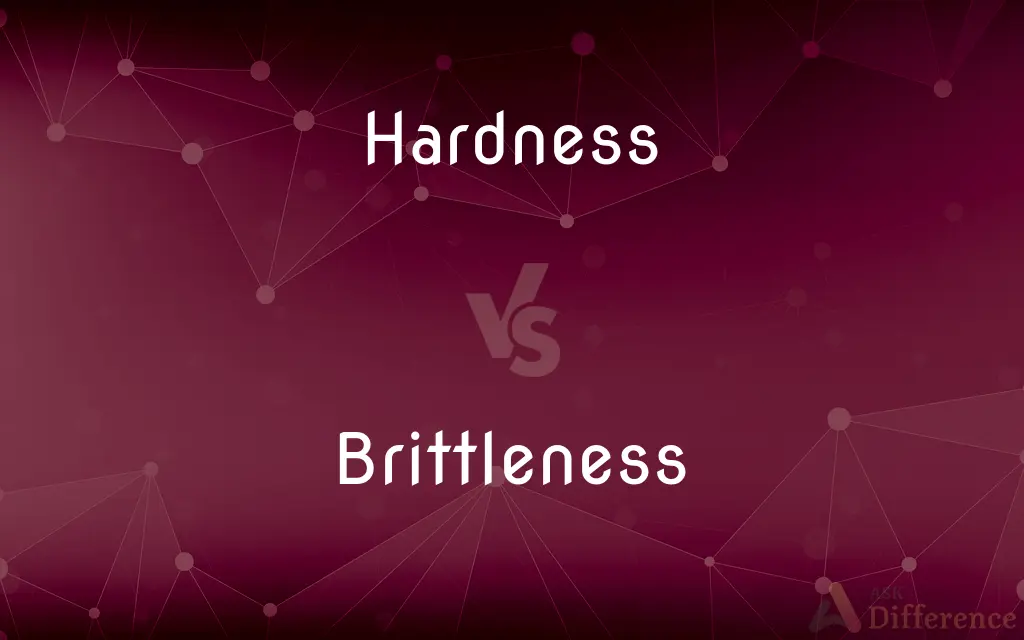Hardness vs. Brittleness — What's the Difference?
Edited by Tayyaba Rehman — By Urooj Arif — Updated on March 11, 2024
Hardness measures a material's resistance to deformation, while brittleness indicates how easily it breaks under stress without significant deformation.

Difference Between Hardness and Brittleness
Table of Contents
ADVERTISEMENT
Key Differences
Hardness is a property of materials that reflects their resistance to deformation, typically seen in the ability to resist scratching, indentation, or bending. It's a measure of how well a material can withstand surface penetration or permanent shape change under applied force. On the other hand, brittleness is a characteristic that describes a material's tendency to fracture or break without undergoing significant plastic deformation beforehand. Brittle materials, such as glass or certain types of ceramics, break easily under stress but do not bend or deform beforehand.
The key distinction between hardness and brittleness lies in how materials respond to applied forces. Hard materials resist surface changes and are difficult to penetrate, which is why they are often used in tools and wear-resistant applications. Whereas, brittle materials may also be hard, but they lack the ability to absorb energy through deformation before breaking. This makes brittleness a disadvantage in applications where impact resistance is crucial.
In terms of testing and measurement, the hardness of a material is often assessed using scales such as the Mohs scale for minerals, which ranks materials based on their ability to scratch others, or the Brinell and Rockwell scales for metals, which measure resistance to indentation. Brittleness, however, is not measured on a specific scale but is evaluated based on the material's behavior under stress, such as in impact tests or by observing the nature of its fracture when it fails.
Material selection in engineering and design often requires a balance between hardness and brittleness. For instance, tools and machinery parts need to be hard to resist wear and maintain their shape under stress but not so brittle that they fail unexpectedly under impact or shock loading. Innovations in materials science, such as the development of toughened ceramics or tempered glass, aim to enhance the hardness of materials while reducing their brittleness, thus broadening their applications.
Understanding the difference between hardness and brittleness is crucial for material science, as it influences the selection process for various applications. Hard materials are sought after for their durability and resistance to wear, while minimizing brittleness is key to ensuring structural integrity and reliability in performance, especially in critical or safety-related applications.
ADVERTISEMENT
Comparison Chart
Definition
Resistance to deformation and surface penetration.
Tendency to break or fracture without deformation.
Key Characteristic
Ability to withstand applied forces without changing shape.
Breaks easily under stress with little to no deformation.
Measurement
Mohs scale (minerals), Brinell and Rockwell scales (metals).
Evaluated through impact tests or fracture observation.
Applications
Tools, machinery parts, wear-resistant surfaces.
Materials where flexibility is not critical, like glass.
Engineering Focus
Maximizing resistance to wear and maintaining shape.
Minimizing to enhance structural integrity and reliability.
Compare with Definitions
Hardness
Measured by specific scales, reflecting penetration resistance.
The Rockwell hardness test assesses metal durability.
Brittleness
Considered a drawback in impact-resistant applications.
Brittle materials are unsuitable for safety helmets.
Hardness
Involves a balance with other properties for practical use.
Enhancing the hardness of a polymer through additives.
Brittleness
Describes materials that fracture easily under stress.
Cast iron, while hard, is brittle and can shatter.
Hardness
Essential for wear-resistant applications.
Hardened steel is used in machining tools.
Brittleness
Not directly measured but observed in material behavior.
The tendency of glass to shatter upon impact demonstrates brittleness.
Hardness
Desired in materials that must maintain their shape under stress.
Bearings and gears are made from hard materials.
Brittleness
Requires careful handling and design consideration.
Brittle materials are often used where deformation is not tolerated.
Hardness
Indicates resistance to scratching or indentation.
Diamond is valued for its exceptional hardness.
Brittleness
Innovation aims to reduce brittleness in hard materials.
Tempered glass offers improved toughness over standard glass.
Hardness
Hardness is a measure of the resistance to localized plastic deformation induced by either mechanical indentation or abrasion. In general, different materials differ in their hardness; for example hard metals such as titanium and beryllium are harder than soft metals such as sodium and metallic tin, or wood and common plastics.
Brittleness
A material is brittle if, when subjected to stress, it fractures with little elastic deformation and without significant plastic deformation. Brittle materials absorb relatively little energy prior to fracture, even those of high strength.
Hardness
The quality or condition of being hard.
Brittleness
Likely to break, snap, or crack, as when subjected to pressure
Brittle bones.
Hardness
The relative resistance of a mineral to scratching, as measured by the Mohs scale.
Brittleness
Easily damaged or disrupted; fragile
A brittle friendship.
Hardness
The relative resistance of a metal or other material to denting, scratching, or bending.
Brittleness
Difficult to deal with; snappish
A brittle disposition.
Hardness
The quality of being hard.
Brittleness
Lacking warmth of feeling; cold
A reputation for being brittle and aloof.
Hardness
An instance of this quality; hardship.
Brittleness
Brilliantly sharp, as in percussive sound.
Hardness
(inorganic chemistry) The quantity of calcium carbonate dissolved in water, usually expressed in parts per million (ppm).
Brittleness
Perishable.
Hardness
The resistance to scratching, cutting, indentation or abrasion of a metal or other solid material.
Brittleness
Fleeting; transitory.
Hardness
(physics) The penetrating ability of electromagnetic radiation, such as x-rays; generally, the shorter the wavelength, the harder and more penetrating the radiation.
Brittleness
A confection of caramelized sugar to which nuts are added
Walnut brittle.
Hardness
The measure of resistance to damage of a facility, equipment, installation, or telecommunications infrastructure when subjected to attack.
Brittleness
The property by virtue of which a material is fractured without appreciable deformation by the application of load.
Hardness
A measure of how hard a material is
The hardness of the material was high.
Brittleness
The state of being brittle; aptness to break; fragility.
Hardness
The quality or state of being hard, literally or figuratively.
The habit of authority also had given his manners some peremptory hardness.
Brittleness
Aptness to break; fragility.
Hardness
The cohesion of the particles on the surface of a body, determined by its capacity to scratch another, or be itself scratched; - measured among minerals on a scale of which diamond and talc form the extremes.
Brittleness
Firm but easily broken
Hardness
The peculiar quality exhibited by water which has mineral salts dissolved in it. Such water forms an insoluble compound with soap, and is hence unfit for washing purposes.
Hardness
The property of being rigid and resistant to pressure; not easily scratched; measured on Mohs scale
Hardness
Devoid of passion or feeling
Hardness
The quality of being difficult to do;
He assigned a series of problems of increasing hardness
Hardness
Excessive sternness;
Severity of character
The harshness of his punishment was inhuman
The rigors of boot camp
Common Curiosities
What determines a material's hardness?
A material's resistance to deformation and penetration by another substance determines its hardness.
Why do brittle materials break easily?
Brittle materials break easily because they are unable to absorb sufficient energy through deformation before fracturing.
Can hardness affect a material's other properties?
Yes, increasing hardness can sometimes increase brittleness, requiring a balance to achieve the desired material characteristics.
How is hardness measured in metals?
Hardness in metals is often measured using the Brinell, Rockwell, or Vickers hardness tests, which assess resistance to indentation.
Why is material hardness important in tool design?
Hardness is crucial to ensure tools resist wear and deformation, maintaining effectiveness and precision in their application.
What are the disadvantages of brittleness?
The main disadvantage is a material's tendency to fail suddenly under stress, which can be catastrophic in structural applications.
Can a material be both hard and brittle?
Yes, materials like glass and some ceramics are both hard and brittle.
Is brittleness a measureable property?
While there's no direct scale, brittleness is evaluated through tests that measure a material's behavior under stress or impact.
What is the impact of brittleness in safety-related applications?
Brittle materials are avoided in safety-critical applications due to their tendency to fail without warning under impact or stress.
How can the brittleness of a material be reduced?
Through material engineering, such as alloying, heat treatment, or the incorporation of fibers or other toughening agents.
Share Your Discovery

Previous Comparison
Altruism vs. Hedonism
Next Comparison
Immortal vs. IndestructibleAuthor Spotlight
Written by
Urooj ArifUrooj is a skilled content writer at Ask Difference, known for her exceptional ability to simplify complex topics into engaging and informative content. With a passion for research and a flair for clear, concise writing, she consistently delivers articles that resonate with our diverse audience.
Edited by
Tayyaba RehmanTayyaba Rehman is a distinguished writer, currently serving as a primary contributor to askdifference.com. As a researcher in semantics and etymology, Tayyaba's passion for the complexity of languages and their distinctions has found a perfect home on the platform. Tayyaba delves into the intricacies of language, distinguishing between commonly confused words and phrases, thereby providing clarity for readers worldwide.














































